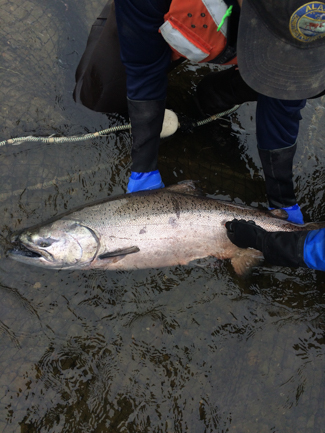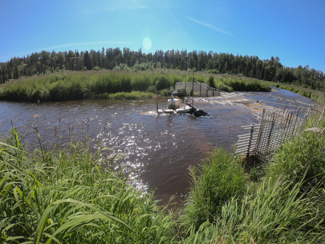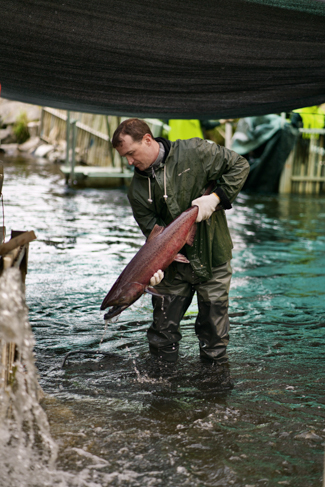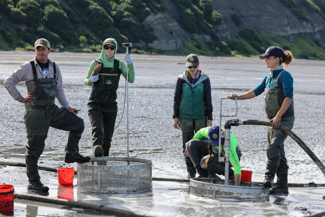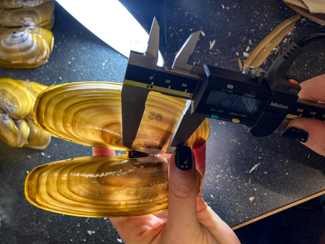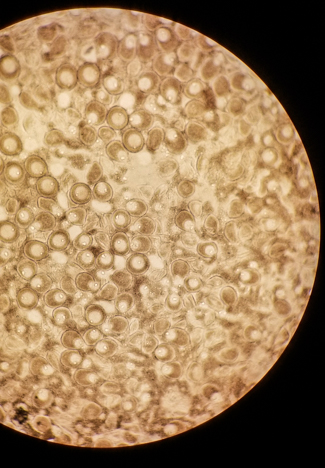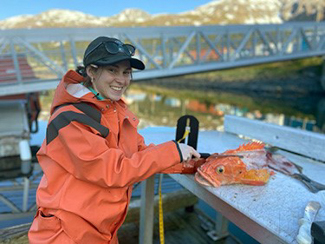Lower Cook Inlet Management Area
Fishing Research
Research
Anchor River Weirs
A weir is installed at river mile 1.7 on the Anchor River by mid-May to monitor the returning Chinook Salmon run. This section of the river typically requires the use of a sonar weir through the end of May when flows subside and allow for a floating video weir to be installed. The video weir uses DVR technology to record a video each time motion is triggered by a fish swimming through the passage chute. Video quality is good enough that species are easily identified and counted.
Chinook Salmon
The Anchor River Chinook Salmon escapement has been monitored by weirs since 2003 and was monitored by aerial surveys beginning in the 1960s. Weir escapements have ranged from a low of 2,338 in 2023, to a high of 12,016 in 2004. The escapement counts, harvest data from the Statewide Harvest Survey, and the age, sex, and length composition data collected during biological sampling are used to assess productivity of the stock. The Sustainable Escapement Goal for the stock is assessed every 3 years using spawner-recruit analysis. The current escapement goal (3,200 to 6,400) has been in place since 2023. The Chinook Salmon run typically peaks in mid to late June but lasts from mid-May through early August. Chinook Salmon in the Anchor River and other lower Kenai Peninsula streams spend 1 year as juveniles in freshwater and 1 to 4 years feeding in saltwater before spawning.
Coho Salmon
Coho Salmon have periodically been monitored by weirs on the Anchor River. This includes the late 80s, 2004-2011, and 2020-present. Escapements have ranged from 1,487 to 20,187 fish. Not all escapements for these years can be considered full enumerations due to monitoring dates not encompassing the entirety of the run. There is not currently an escapement goal for the Anchor River Coho Salmon stock. Anchor River Coho Salmon spend 1 or 2 years rearing in freshwater and 1 year feeding in saltwater before spawning.
Steelhead
Steelhead have been monitored intermittently on the Anchor River, and the average annual run size for this river is believed to be about 1,000 fish. Two complete weir counts have occurred; one in 2020 with a total count of 552 Steelhead and one in 2024 with a total count of 1,389 Steelhead. Steelhead begin entering the Anchor River in early August, but peak run timing occurs between mid-September and early October. Steelhead that are returning to spawn for the first time are typically 20 to 25 inches long, while steelhead that are on their third or fourth spawning trip can be greater than 34 inches. Steelhead spend the winter in the river, spawn in the spring, and migrate back to the ocean after spawning as "kelts". During some springs, more than 500 kelts have been counted through the weirs set up to monitor Chinook Salmon on the Ninilchik River and the North Fork of the Anchor River.
Anchor River Chinook Salmon Marine Survival
This project began in 2025 to assess the marine survival of Anchor River Chinook Salmon. A rotary screw trap placed in the Anchor River is used to catch smolt as they out-migrate to the ocean. Chinook smolt are measured, weighed, tagged with PIT tags, and released back into the river. As adult Chinook migrate back to the Anchor River to spawn, a specialized array fitted to the video weir chute will detect and record the unique PIT tags for each tagged salmon. This data will then be compared to the juvenile PIT tag data to determine the marine survival of Anchor River Chinook Salmon.
Ninilchik River Chinook Salmon Escapement
The Ninilchik River Chinook Salmon escapement was counted by aerial surveys from the 1960s until the broodstock collection weir, located at river mile 5, also began monitoring escapement in 1999. Chinook Salmon escapement is currently monitored downstream of the broodstock collection weir at river mile 2 using a floating video weir. The current escapement goal of 900 – 1,600 wild Chinook Salmon was established in 2023. Approximately 15% of the wild Chinook salmon spawn between the broodstock weir and floating video weir based on count comparisons while operating both. The high video quality produced by the floating video weir easily allows for identification of the presence or absence of the adipose fin, allowing weir counts to be differentiated by wild and hatchery Chinook Salmon.
Chinook Salmon Broodstock Collection and Stocking
Broodstock Collection
Every year, Ninilchik River adult Chinook Salmon are collected and spawned at the broodstock collection weir to provide the next generation of smolt to be stocked into the Ninilchik River and to stock the terminal fisheries in the Nick Dudiak Fishing Lagoon on the Homer Spit and Seldovia Lagoon across Kachemak Bay. Chinook Salmon are collected and held at the weir until they are ripe (ready) for spawning. Wild Chinook Salmon are not held until the wild escapement goal has been met but all hatchery Chinook Salmon are held at the weir to reduce the hatchery contribution into the escapement. Egg takes (spawning events) typically occur during the last two weeks of July and first week of August, when Chinook Salmon are naturally ripe and ready to spawn.
Ninilchik River Supplementation
The Ninilchik River has been supplemented with hatchery Chinook Salmon smolt since 1987. Only wild Ninilchik River Chinook Salmon are used to create smolt to re-stock the Ninilchik River. The eggs are reared over the winter in the William Jack Hernandez Sport Fish Hatchery on Ship Creek in Anchorage and are stocked the following summer into the Ninilchik River. Smolt are stocked at a location upstream of the broodstock collection weir in mid-June, which is the same time that wild juvenile Chinook Salmon become smolt and out-migrate from the system. The number of smolt stocked into the river per year has varied but the goal is currently at 150,000 smolt per year.
Kachemak Bay Saltwater Stocking
The hatchery Chinook Salmon that are collected at the Ninilchik River broodstock collection weir are spawned to create smolt to stock the enhanced fisheries in Kachemak Bay. This includes the Nick Dudiak Fishing Lagoon on the Homer Spit and the Seldovia Lagoon on the south side of Kachemak Bay. Approximately 315,000 Chinook smolt are stocked in the Nick Dudiak Fishing Lagoon each year and about 105,000 are stocked in Seldovia. Smolt are held in net pens in the NDFL for about 24 hours to assist with imprinting and allow them to adjust to the saltwater and feed before being released.
Cook Inlet Razor Clam Stock Assessment
East Cook Inlet
The East Cook Inlet razor clam stock is intensely monitored with annual abundance surveys, size and age surveys, and maturity assessments. Check out the most up to date information on the stock since the 2015 fishery closure with our YouTube video: Online Fishing Forum: What's Going on With East Cook Inlet Razor Clams? - YouTube
Abundance Surveys
Abundance surveys are conducted annually in the spring at both Ninilchik and Clam Gulch beaches. They are conducted by using a water pump to emulsify plots of substrate on transect lines within beach sections. The razor clams float to the top of the plot when the substrate is liquified and are captured so they can be enumerated, measured, aged, and placed back unharmed. These surveys produce data for estimates of juvenile and adult sized razor clam abundances, rates of natural mortality between years, and the recruitment estimates of juvenile and adult razor clams.
Size and age (hand digging) surveys
Department staff collect samples from 9 beach sections in East Cook Inlet during a single tide series in June annually. The shells are processed in the lab so they can be measured and aged. Each individual annulus on the shell is measured, providing the annual growth rate by clam cohort. This data set is extensive and is annual beginning in the 1960s. The samples are collected by hand digging as they are meant to represent the size and age composition of the harvest.
Maturity assessment
Razor clams are broadcast spawners that release their gametes into the water column between July and September in Cook Inlet. One female can release approximately 6-10 million eggs. Department staff have periodically collected razor clams during that timeframe to assess the timing of the spawn by observing the maturity of the gametes under a microscope in the lab.
West Cook Inlet
Marine Recreational Groundfish Research
The department monitors sport harvest of groundfish species (halibut, rockfish, lingcod, etc.) in Kachemak Bay and Cook Inlet (as well as the other marine waters of Southcentral Alaska) and has since the early 1980s. Department port samplers are stationed at popular sport fish landing sites such as Homer, Deep Creek, and Anchor Point and are tasked with collecting biological samples as well as angler effort data. Biological sampling involves getting lengths and sexes of fish as well as ages. The ages are obtained by collecting a bony structure from the carcass such as the otolith (ear bone) or fin rays. Interview questions are asked to obtain data about the time spent fishing for different species and which areas were fished.


